 Inter-County
Inter-CountyCommunity Council
-
1-888-778-4008
1-218-796-5144
1-833-792-1046 (fax) -
Monday – Friday
8:00AM to 4:30PM
Check Your Propane Tank
Check Your Tank: Why It’s Important and How to Do It
Did you know that it’s important to check your tank periodically? Maybe you just moved into your first home with a propane or a fuel oil tank? Or perhaps you are renting from someone and it’s your first experience with this sort of heat. If you just bought your first house, dealing with propane or fuel oil might be all new to you!
Either way, it’s important to check your tank periodically.
If you have no experience with caring for propane or fuel oil, the whole idea might be a bit…. daunting. Will the tank explode? How do you know if there is a leak? Is it safe to have the fuel oil tank inside your house?
You know these are dangerous elements, and you want to be sure to properly handle them.
But at the same time, it’s so easy to totally forget about them! You wake up in the morning to a nice, cozy house, you have a hot shower and a good breakfast on the stove. Life is good!
You might think about your tank when you first move in, but after that? Life gets you busy. And you start taking your heating system for granted.
In this article, we will cover why it is important to check your tank, and what can happen if you don’t. I’ll walk you through the proper way to check your tank, and how often you should check your tank.
And finally, I’ll leave you with a few people you can call, when you need to fill your tank or if you (heaven forbid!) need someone to come on out and service your tank.
So, let’s get started!
Why Do You Need to Check Your Tank?
You might think that the only time you need to check your tank is if you are running low on propane or fuel oil.
And while that is certainly true, (because, who wants a cold house?) maintaining fuel levels and a full propane tank is not the only reason why you should check your tank.
Why You Need to Check Your Propane Tank
There are numerous reasons why you do not want your propane tank to get too low. The most obvious is that you will run out of propane before you realize it, and your house will be cold.
If that happens, then you will have to make an emergency call to your service provider and ask for a fill. Since it is an emergency, they are likely to charge you more.
Worse still, it may be the weekend. Or it may be after-hours. They may not be delivering. So then, not only do you have to wait until normal delivery hours, but you still most likely will need to pay an emergency delivery fee.
Oh, and let’s not forget that we live in Minnesota! We are known for some brutal winters and horrific snowstorms. When that happens, a lot of businesses shut down, sending their workers home – to safety.
Which is where you will be – safely at home, and freezing to death, with no propane. Waiting out the storm. And waiting for the road crew to clear the snow, so that your delivery guy can get to you.
It’s not a pleasant scenario, but unfortunately, it can – and does – happen. So, obviously the number one reason to make sure you check your tank is to keep your home heated, at all times. Especially in the midst of a winter storm.
But there are other reasons to check your tank as well.
You Need to Check for Leaks
Did you know that propane, in its natural state, is odorless?
Neither did I!!
Because propane has no odor, it has made it hard for people to check for leaks. So, to make it easier - and safer - for us, it has been infused with a ‘rotten egg smell’, so that we can tell if we have a leak. Who knew?
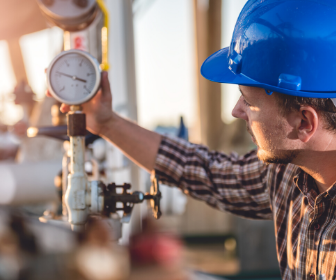
If you’ve never smelled propane before, then the next time your propane provider comes on out to your house, ask him or her if you can see what propane smells like. Explain to your service provider that you just want to be familiar with the smell, so that you can spot leaks.
And then, if you ever smell that rotten egg smell around your propane tank again, evacuate the house immediately and call your service provider.
Propane is flammable and can leak into the air. If it is near electricity, or anything else that can cause a spark, it could cause an explosion.
Generally speaking, propane is safe. You don’t need to panic or be worried about your propane tank. It should heat your home quite nicely, and you can have your hot shower and warm breakfast without ever thinking about your propane tank.
As long as you periodically check it for leaks.
If You Run Out of Propane, Your Appliances Will Stop Working
One thing I never realized, with propane, is that it fuels your appliances.
See, the majority of homes I’ve ever owned or lived in have been fueled by electric heat or fuel oil. So, I was surprised the first time my husband told me our stove wouldn’t work if we didn’t fill the propane tank!
Your stove, your fridge, and the hot water heater will all quit working if you run out of propane.
It’s another good reason to check your tank.
Because, if you run out of propane, not only do you now have a cold house, but you also can’t cook that hot breakfast, you can’t take that warm shower, and everything in your refrigerator will spoil!!
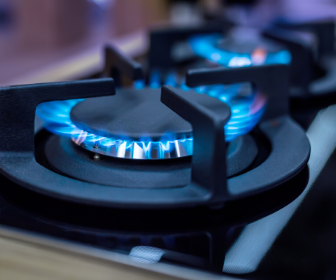
If You Run Out of Propane, Your Heater Will Not Work
I know that you know you will be cold, if you run out of propane. Because propane heats your house.
But there are so many more problems than just heating and appliances. If you run out of propane, your pipes could freeze and burst – especially here, in Northern Minnesota. This could cause water damage in your home and you will have to repair the pipes.
The average cost of water damage from frozen pipes is around $15,000, according to State Farm Insurance.
Who wants to pay that?!? It is so much easier to just periodically check your tank and make sure you have enough propane.
If You Run Out of Propane, Your Tank Could Be Ruined
Running your propane tank dry can actually harm your tank. If open air and moisture get inside your tank, it could cause rust.
And the implications of a rusty tank are far more serious than just a dirty tank. Remember that rotten egg smell?
If your tank is rusty on the inside of the tank, it will mask that rotten egg smell. You won’t be able to smell your propane anymore.
So, it will be difficult to check for a leak.

If You Run Out of Propane, The Law Requires You to Have Your Tank Inspected Before Refilling It
And, while this may be a pain for you (and cost you oogles of money), you have to understand that it really is the best time to be sure there’s no rust inside your tank! You want to be able to smell your propane, so it makes sense that the government would require an inspection once the tank runs dry.
It does, however, cost you more money. Plus, you will most likely have to be there at the time of the fill. (Otherwise, normally the delivery man or woman can fill your tank, even when you aren’t home.)
So, it is a nuisance, to let your tank run completely dry. It really is better to keep an eye on it, and have it refilled before it gets that low.
If You Fail to Check Your Propane Tank, It Could Cost You More Money
There are so many reasons you should check your propane tank on a regular basis! It might be tempting, to put off filling it, until it is completely dry. Especially because it isn’t cheap, to fill your propane tank.
But if you put off filling it to save a little money now, it can cost you a lot more money down the road. You may find yourself paying for emergency fees, an inspection, or even, tank repairs.
Add that to the cost of actually filling your tank, and you saved nothing.
Not only did you spend more, but filling the tank actually became a nuisance, requiring more of your time. And if you had to take time off of work to be there when the service man inspected the tank, well, then you lost out on even more money.
So, go check your tank!
Why You Need to Check Your Fuel Oil Tank
Fuel oil is different from propane. Propane is a gas, that is normally compressed, and stored as a liquid. It is nontoxic and colorless, and of course, odorless, as I mentioned earlier.
Propane is a natural gas, also sometimes called ‘liquified petroleum gas’, or LPG.
Fuel oil, on the other hand, is made from crude oil. It is actually closely related to diesel fuel – the same stuff that they sell at the gas station. Unlike diesel fuel, however, fuel oil is dyed red.
They are two very different elements used to heat your home. So, when you check your tank, you need to be checking for different things if you have fuel oil than you do if you have propane.
You Need to Check for Leaks
Aside, from the obvious – the possible scenario of freezing to death during a Minnesota winter storm – there are many reasons why you should routinely check your fuel oil tank. If you run out of fuel, your house will be cold. But so many other things can go wrong as well.
A leaky fuel oil tank can induce heavy environmental hazards. If your fuel oil tank is leaking, it is going to harm not only your house and property, but others living around you or within the community as well.
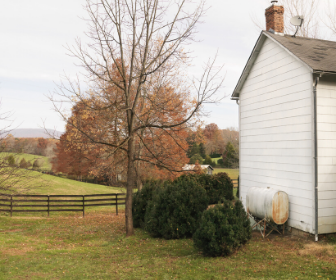
And as you can imagine, the costs for cleaning that up are extreme. One article quoted a few thousand dollars to well over $100,000, depending on the extent of the environmental damage. That is not a cost you want to have to pay.
There are two types of fuel oil tanks: above ground, and below ground. You need to check for leaks in different ways, depending on which tank you have. Also, the implications of a leaky tank vary as well, depending on which type of tank you have.
Checking for Leaks with an Underground Tank
If you have an underground tank, a telling sign might be the smell of oil in your home. You can also look for dead vegetation in the yard. If plants and grass are dying in the spot that your tank is buried, you could have a leak.
If your home has a sump pump in it, you can check the water. Use a jar to dip into the water. If there is oil in the water, it will rise to the top of the water, and float on the surface. This will indicate a leak.
But the best way to tell is to have a soil test done. So, if you see any or all of the above signs, you will want to have someone come out and take a look.
Checking for Leaks with an Above Ground Fuel Oil Tank
There are a lot of ways to check for a leak in an above ground fuel oil tank. For the complete list, click here.
But some of the most obvious – and easiest – include:
- Signs of rust or wet spots on the tank.
- Drips or signs of leaks around the tank.
- Stains on the ground around the tank.
- A strong fuel smell.
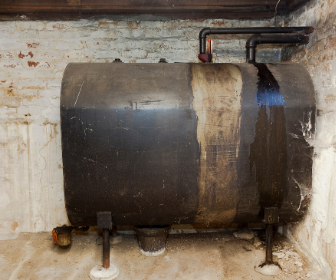
The cost to clean up oil contamination is incredibly high, and often not covered by insurance. That means you have to pay for it, if your tank leaks. It’s best to have your tank regularly inspected, so that you can prevent leaks in the first place.
If You Let Your Fuel Oil Drop Below 4 inches, Your Furnace Will Stop Working
Another reason you should check your tank is because your furnace can stop working. Your furnace needs fuel to burn, in order to make heat for your home. Without it, you will be cold.
You already know that. But what you might not know is that your tank does not have to be completely dry, in order for your furnace to quit working.
If you have four inches of fuel in your tank (or less), your tank is not bone dry. But it is too low for your tank’s feed line to pick up the oil. That means oil is not being pumped into your furnace, and your furnace cannot run.
You should never let your fuel oil drop below eight inches.
You Need to Check Your Fuel Oil Tanks Because Sediment Can Settle on the Bottom
If you have an older tank, impurities – or sludge – could have settled onto the bottom of your tank.
‘Sludge’ is what happens when your fuel oil is left in your tank for an extended period of time. The oil is exposed to air, light and heat, and this creates chemical reactions. These chemical reactions cause large molecules to form and collect on the bottom of your tank as ‘sludge’.
When you let your fuel levels drop, you have a higher chance of sucking this sludge into your feed line. This can clog the line. This sludge can also travel through the line and clog your nozzle or furnace filter.
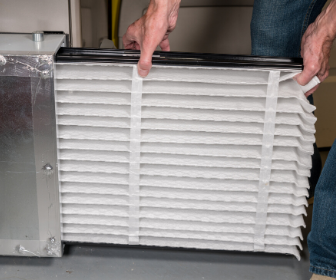
At the very least, your furnace will not run properly if you have a clogged line, nozzle or filter. It will be less efficient and use up more fuel to heat your house. This will cost you more money.
And at the very worst, it will shut down entirely.
This is a pretty involved process, and you will most likely need to call a heating engineer, to have it serviced.
Water Can Leak into Your Tank, making it More Likely to Suck Up Sludge
If water has leaked into your fuel oil tank, it will sit on top of the fuel oil. This will give you a false reading when you check your fuel oil levels. It will make it seem like you have more fuel in your tank than you actually do.
And then you will let your fuel level dip down lower than you should, increasing the likelihood of sucking up sludge, into your feed line. You also risk sucking up that water into your feed line.
This can clog the nozzle and prevent the burner from operating properly, forcing you to have your furnace serviced.
You Need to Check Your Fuel Oil Tanks Because the Readings Can Be Misleading
The bottom of a fuel oil tank is rounded, so it is often misleading. The actual fuel oil level is not always accurate. And because of this, you may think you have more fuel than you really do, causing you to run out faster than you thought you would.
When you put a dipstick into your fuel tank, it may give you a reading of 20 inches. But that 20 inches actually represents a lot more fuel than a reading of five inches would, simply because the bottom of the tank is rounded.
So, it may take several days to drop from 20 inches to 19 inches, but if you are at five inches, you can drop to four inches in a single day.
And again, you should never let your fuel oil drop below eight inches.
Failing to Check Your Fuel Oil Tank Can Cost You a Lot of Extra Money
It might be tempting to let your tank run as low as you can. The cost of filling it is a hard pill to swallow. But the costs of not filling it is an even bigger pill.
If you let your tank run too low, you will risk ruining your home furnace. It will need to be repaired or replaced, and that isn’t cheap.
If you forget to regularly check your fuel oil tank, you may spring a leak, and never know it. The costs of oil clean-up is high.
It’s best to regularly check your tank and bite the bullet when it gets low – fill it immediately. This will keep your furnace running, your tank from leaking, and save you a lot of money in the long run.
How Do You Check Your Tank?
Knowing how much propane or fuel oil you have in your tank will prevent all kinds of horrible disasters! You could ruin your furnace or ruin your environment.
But staying warm on a frigid Minnesota day is the best reason to check your tank.
And yet, how, exactly, do you check your tank?
How to Check Your Propane Tank
Wouldn’t it be great if we could just walk up to our tank, peer inside, and see how much propane we actually have? Much like you can tell how much water is in your glass?
It’s a funny thought, because propane is a colorless gas, and your tank is not see-through.
So, how do you know how much propane is in your tank?
How to Find Your Propane Gauge
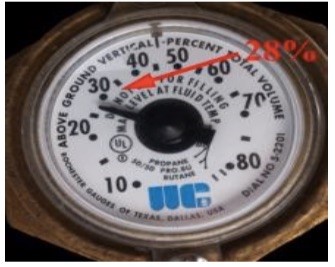
You need to read your propane level with the propane gauge.
Your propane gauge is at the top of your propane tank. It is sitting under the dome, which looks like a hat, sitting on top of your tank.
The gauge looks like a watch – there are bold, black numbers going around it, much like the hours around a watch or clock. And there will be one needle.
This needle will point to numbers. These numbers represent a percentage. Your propane tank is considered “full” at 80%. So, if the needle points at 80, you are good to go.
How to Read Your Propane Tank Gauge
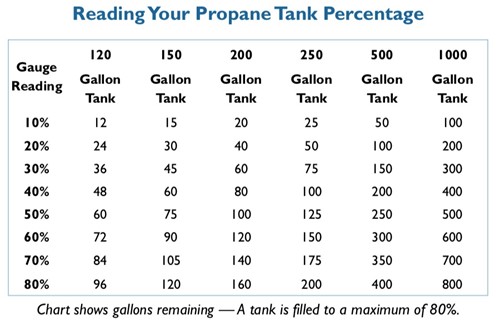
This chart shows how much propane is left in your tank, based on the number your propane gauge gave you and the size of your tank.
For example, if you have a tank that holds 150 gallons, and your gauge shows 40, that means you have 60 gallons of propane left. If your tank holds 250 gallons, and your gauge reads 20, then you 50 gallons left.
When Should You Fill Your Propane Tank?
You should have your tank filled before it drops down to 20%. If you look at the chart above, 20% signifies that you have anywhere between 24 and 200 gallons left, depending on the size of your tank.
Knowing when to fill your tank is an exact science. You need to consider a variety of things, like how often you use your appliances, how much energy they take to run, and how much propane your boiler takes to heat your house. It’s kind of hard to estimate these things.
So, to be safe, your best bet is to always get it filled at 30%. If you drop below 30% and are worried about what could happen, click here.
How to Check Your Fuel Oil Tank
Your fuel oil tank, of course, is slightly different than a propane tank. And even though fuel oil is red, we still can’t peer into the tank to see how much we have left. So, we have to read the gauge or do a stick test.
How to Read the Gauge on the Top of Your Fuel Oil Tank
The most common fuel oil tank is oval-shaped and is often located inside the home. It usually holds about 275 gallons.
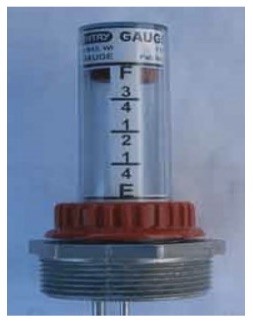
The gauge on the top of your fuel oil tank is called a “float” and it tells you how much oil is left in your tank. It is read in fractions – ¾, ½, and ¼. This means that your tank is either full, three-fourths full, half full, or just a quarter full. If you drop down below ¼, you need to have your tank filled.
How to Check Your Fuel Oil Tank When You Do Not Have a Gauge
Not all tanks have a gauge. But you can still check your fuel level by doing a simple stick test.
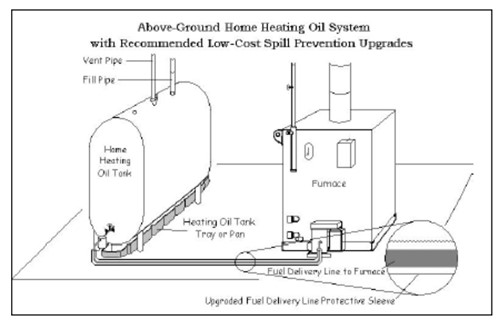
Image Source: energy.gov
To do a stick test:
- Insert a one-inch rod into the fill pipe and lower it down until the rod touches the bottom of the tank.
- Pull the rod out of the tank and take a look at how much of the rod is wet with fuel oil.
- Hold the rod along the outside of the tank, lining up the bottom of the rod with the bottom of the tank.
- Use the wet level on the rod to estimate about where the fuel level is on the tank. Is it at about ¼ of the tank? Or is it at ½ or ¾? If it’s about a quarter full or less, you need to have it filled.
Or, you can use the following chart to determine how much fuel you have left in your fuel tank:
If the oil level on your rod measured about 4 inches, and your tank holds 265 gallons, then you have about 14 gallons left. If your rod measured 4 inches, and your tank holds 560 gallons, then you have about 22 gallons left.
If your tank holds 265 gallons, and ¼ of 265 gallons is 66 gallons, you are going to want to have your tank filled if your rod shows less than 13 inches. So, if it is measuring at 4 inches, you have a dire emergency on your hands!
You will need to call immediately and have your tank filled.
How Often Should You Check Your Tank?
Regularly! Often! The best way to remember to check your tank is to make it a part of your daily or weekly routine.
Come home from work, shut the garage door, check the tank.
Start your car, let it warm up, check the tank.
Walk into the storage room, grab some wrapping paper, check the tank.
Or, maybe you check the tank every Sunday, or on the first day of every month.
Whatever system you use, find one that will make it easy for you to remember to check your tank.
How Often Should You Check Your Propane Tank?
Emily Hallie, Energy Assistance Director at Inter-County Community Council, recommends that you check your propane tank every single month.
Checking your tank will not only keep you from running out of propane in those freezing cold winter months, but it will also make sure that your tank is functioning properly.
How Often Should You Check Your Fuel Oil Tank?
Your fuel oil tank should be checked every month during the winter months as well. You can go longer in the summer months, of course. But every time you check your tank, make sure you look for rust spots, leaks, and damp patches under the base. Always make sure that the caps are put back on correctly as well.
Who Should You Call to Fill Your Tank?
If your propane tank is at 30% or less, it is time to get it filled. Likewise, if your fuel oil tank is at a quarter full – or less, it is time to get it filled. To fill your tank, simply call your local fuel vendor for a delivery.
If you do not know who that might be, you can do a Google search online or you can look in the telephone book. You can also ask your neighbor or your landlord.
If you are refused delivery, you should contact the Inter-County Community Council Energy Assistance Department at (218) 796-5144 ext. 1020.
Failing to Regularly Check Your Tank Can Cost You More Money Than Filling It
In conclusion, if you are trying to save a little dough by running your tank as low as you can before having to refill it – don’t!! It will cost you more money in the long run.
➤ You could end up paying for damages caused by a leaky tank.
➤ You could end up paying for tank tests and repairs.
➤ You could end up paying for a damaged furnace.
➤ And you could end up paying for emergency delivery fees.
It’s cheaper – and easier on your peace of mind – if you just fill your tank when it gets low.
If you need help with heating costs, please contact your local community action agency, or, if you are in Northern Minnesota, Inter-County Community Council at (218) 796-5144 ext. 4.
Stay safe and warm this winter!
Author Byline:
Shannon Lambert is a freelance writer for hire who offers ghostwriting, copywriting and blogging services. She works with businesses and nonprofits, providing engaging content that educates their readers.